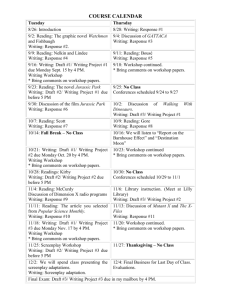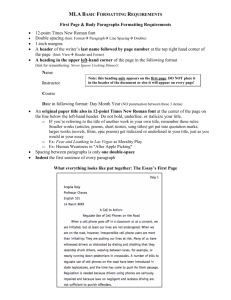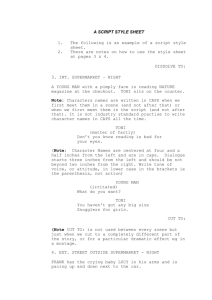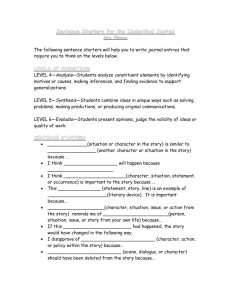How to Format a Screenplay
advertisement
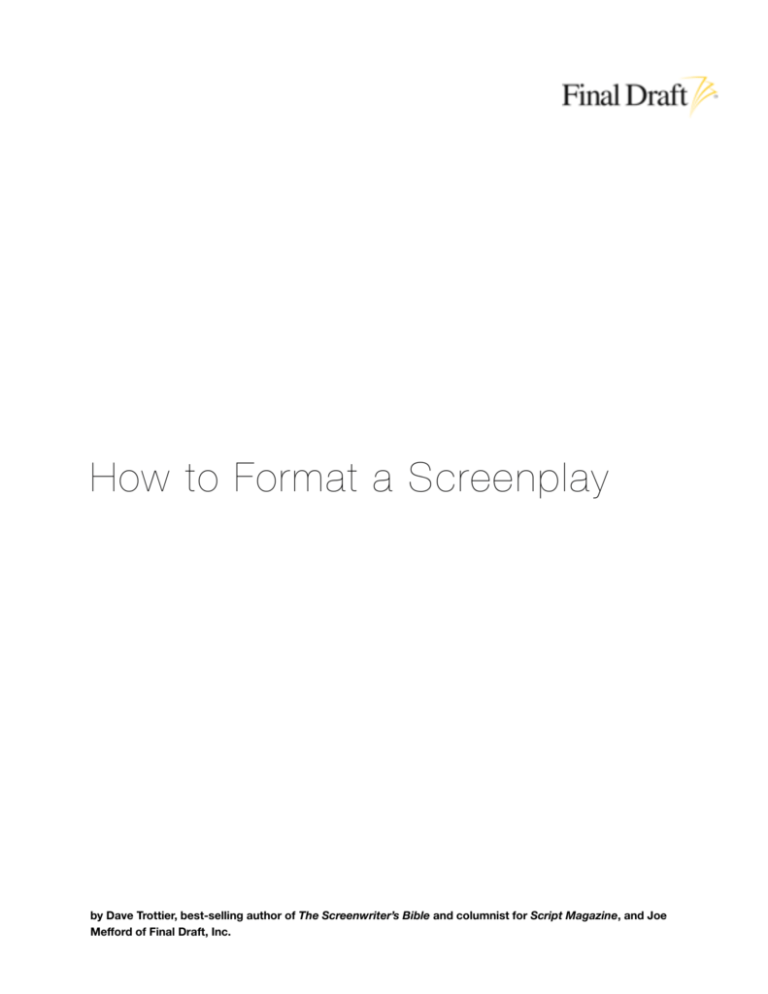
How to Format a Screenplay by Dave Trottier, best-selling author of The Screenwriter’s Bible and columnist for Script Magazine, and Joe Mefford of Final Draft, Inc. Compliments of Final Draft, Inc. - the #1 scriptwriting software program. www.finaldraft.com INTRODUCTION TO SCREENPLAY FORMAT So you've got this great idea for a movie. Perhaps itʼs a movie that you want to direct or produce. Or maybe it could be the next Hollywood blockbuster. But before you can produce or direct or even sell your movie, you have to write the screenplay in the correct entertainment industry format. This guide will teach you the basics of screenplay format using examples from Final Draft Software. Final Draft is the entertainment industry standard for writing and formatting screenplays. A properly formatted screenplay serves two purposes. The first purpose is to tell a story. If you write your screenplay well, your description of a great battle will explode in the readerʼs ears, your dialogue between two lovers will cause the readerʼs eyes to tear up, and that emotional speech you write from a great leader will leave a lump in your readerʼs throat. When you read a great screenplay, you see the movie in your mind and canʼt wait to see it on the big screen. But a screenplay also serves a necessary secondary purpose as a tool for the filmmaker. A screenplay is a working document – a blueprint, if you will – that makes it possible for the director, the cinematographer, the actors, and the many crew members to do their jobs. Before your screenplay can be turned into a movie, your script must be broken down into many elements. In Hollywood-speak this is known as a “script breakdown.” When you breakdown a script, you must figure out how many minutes a scene will take to shoot, which actors you need, and where the scene will be shot or filmed. For just one small scene, you might have to find a horse, blow up a Cadillac, or find a location in Texas that can double as Mars. You can imagine that even the lowest-budget independent film still requires the director to make hundreds – if not thousands – of decisions before he or she ever yells, “Action!” For many years, Hollywood relied upon legions of low paid assistants armed with notepads and pencils to break down scripts and keep production moving forward. But since 1991, much of Hollywood has instead relied upon Final Draft Software. When you write a screenplay with Final Draft software, youʼre guaranteed to write a screenplay formatted to the entertainment industry standard. But, more importantly, your screenplay will be written in the proprietary Final Draft file format (.fdx) that integrates natively with the professional production, scheduling, and budgeting tools that most filmmakers use. How to Format a Screenplay - Compliments of Final Draft, Inc. - www.finaldraft.com 1 Compliments of Final Draft, Inc. - the #1 scriptwriting software program. www.finaldraft.com Why is it important to write your script in the Final Draft format? Screenplays written with a typical word-processing program or a free web-based screenplay template canʼt be used in professional film productions. They often must be retyped or have to go through a complicated conversion process to get them ready for production. Screenplays written in Final Draft and saved in the .fdx format are ready for professional use. Final Draftʼs professional quality is why so many agents, directors, and producers will tell writers to only send them a screenplay written in Final Draft. Itʼs also why so many Oscar®-nominated films – including the Oscar®-winning films The Kingʼs Speech and The Social Network – were written with Final Draft. And itʼs not just screenplays you can write with Final Draft. With Final Draft, you can also write stage plays, musicals, sitcoms, TV dramas, novels, and even graphic novels. Final Draft is used professionally all over the world. Final Draft is a U.S. company and is extremely popular throughout Hollywood and even Broadway. But Final Draft is also used professionally throughout the United Kingdom, Canada, Australia, Germany, France, and over 60 other countries. We have dictionaries in English (U.S., Canada, and British), Catalan, Danish, Dutch, French, German, SwissGerman, Italian, Norwegian, Portuguese (Brazilian and European), Spanish, and Swedish. Want to read a professional screenplay written in Final Draft? On the next page is a scene from the hugely successful film The Kingʼs Speech. The screenwriter, David Seidler, won the 2011 Oscar® for Best Original Screenplay. Mr. Seidler is also a long-time Final Draft user. In this scene, “The Johnsons” (really, the Duke and Duchess of York) first arrive at the office of Lionel Logue. Mr. Logue is a speech therapist and has been hired by “Mrs. Johnson” to help her husband get rid of his stammer. As you read this scene, pay attention to the different elements of the screenplay. Also, note that the screenwriter uses as few words as possible. Well written screenplays are cleanly written and keep the story moving forward. How to Format a Screenplay - Compliments of Final Draft, Inc. - www.finaldraft.com 2 Compliments of Final Draft, Inc. - the #1 scriptwriting software program. www.finaldraft.com How to Format a Screenplay - Compliments of Final Draft, Inc. - www.finaldraft.com 3 Compliments of Final Draft, Inc. - the #1 scriptwriting software program. www.finaldraft.com GETTING STARTED No matter your life experience, age, or level of education, you have a story to tell. Whether you live in Nome, Alaska; Tampa, Florida; or Ottumwa, Iowa, you have a story to tell. Hollywood alone produces 600 movies per year. Add in the television industry, independent films, and markets outside the United States and there are thousands of professional opportunities every single year for storytellers just like you. But for now, you will be starting where every successful screenwriter starts, with the spec script. A spec script is one written “on speculation” which means it has not yet been sold or produced. In this guide, weʼll be showing you examples from scripts for feature films. TV scripts build on this same basic formatting, but also include additional information that varies by genre, studio, or production company. Although there are few rigid rules about formatting a spec script, there are generally accepted guidelines that you need to know. PAGE MARGINS Let's start with the margins. The top margin is one of those rigid rules: It needs to be one inch. Your bottom margin, and your right--or outside--margin can vary from that by up to a quarter-inch. Your left, or inside, margin needs to allow space for the three-hole punch binding, so that should be about one-and-a-half inches. FONT AND PAGE NUMBERS The font is another one of those rigid rules. It must be the Courier font and 12 points. This is an entertainment industry standard. It makes it easier to estimate screen time from number of pages. Trying to get fancy, with any other font, and your script looks amateurish. The top of the page--or header--is also lean and clean. All you should have there is the page number, flush right, about a half-inch from the top of the page, and followed by a period. Except for the first page. It shouldn't have a page number on it at all. YOUR FIRST LINE The first line of your script should be just as good as the first line of any blockbuster. In fact, it should be exactly the first line of virtually every blockbuster script, which is: FADE IN, typed all upper case, flush left, followed by a colon, on a line all by itself. With your next line, youʼll start your very first scene. How to Format a Screenplay - Compliments of Final Draft, Inc. - www.finaldraft.com 4 Compliments of Final Draft, Inc. - the #1 scriptwriting software program. www.finaldraft.com SCENE HEADINGS Everything in a screenplay is organized into scenes, and every scene starts with a scene heading, which can also be called a slug line. These terms are interchangeable. Read these lines below from the hit movie Youʼve Got Mail. The first line is the scene heading. EXT. KATHLEEN'S STREET - DAY Joe, on his way to Kathleen's apartment building, carrying a bunch of daisies, wrapped in cellophane. Joe goes up the stoop to her building and looks at buzzer. Sees Kelly, 3A. He presses. Nothing. Presses again. This scene heading is typical. It has three parts. The first one tells you whether the camera is placed outside, or exterior, which is abbreviated EXT; or inside, which is INT, for interior scene. Next is the location of the scene. This can be as specific as Billy's Bedroom, or as broad as Wyoming. In this case, it's Kathleenʼs Street. Last is time of day. It's best to write only day or night. Specific times are not used, although you might use a general time of day, like sunrise or evening if that's critical to making the scene work. Here's a scene heading from the following scene that's a little different. INT. KATHLEEN'S APARTMENT - SAME TIME Kathleen, in her pajamas, at the intercom, horrified. Why do you think that for time of day it says Same Time? The answer is that it means just what it says: that this scene is happening at the same time as the one right before it, which is Joe, at the front door of her apartment building. So the first scene is Joe pressing the buzzer, then the next scene is Kathleen responding: Two different perspectives, of one event, at the same time. How to Format a Screenplay - Compliments of Final Draft, Inc. - www.finaldraft.com 5 Compliments of Final Draft, Inc. - the #1 scriptwriting software program. www.finaldraft.com A scene can be short. Again from You've Got Mail, here are a couple scenes that are only one shot each. INT. STARBUCK’S - DAY Kathleen picks up her coffee and walks out. EXT. COLUMBUS AVENUE - DAY As Kathleen walks down Columbus, we see Joe a block behind her. She stops to buy flowers and Joe passes her, crosses to the East side of Columbus Avenue. Even though none of these scenes have dialogue we can still “see the movie in our mind.” When youʼre finished with a scene, just start a new one by writing a SCENE HEADING. Nothing else is needed. In some rare cases you might want to end your scene and call for a specific transition such as DISSOLVE or JUMP. In this case, you can use Final Draft and choose the Transition element. A transition looks like this: DISSOLVE: This transition is in the correct format: all capital letters, followed by a colon, and flush right. Because most scenes end with a cut you don't need to point out the obvious. Scripts that end scenes with "cut-to," written out, or use a lot of any type of transitionals, look amateurish. Only use a transition to the next scene when absolutely necessary. There are other special headings and situations that we don't have time for here, but you can learn about them in The Screenwriter's Bible. How to Format a Screenplay - Compliments of Final Draft, Inc. - www.finaldraft.com 6 Compliments of Final Draft, Inc. - the #1 scriptwriting software program. www.finaldraft.com ACTION AND DIALOGUE Screenplays are made up of scenes and scenes are made up of action and dialogue. The format of these elements is pretty simple. Action extends out to both margins. It's single-spaced and is simply a present-tense description of what the audience sees. Hereʼs an example of an action line from the movie L.A. Confidential. Reporters scribble as the Chief speaks. Uniforms everywhere along with Exley and Loew. Bus sits in the back. It's lean, clean ... easy to read. It's good. Action should never try to explain what a character is thinking. You would never write something like "Jane thinks her blind date has appalling table manners." If that's the case, give the date something appalling to do, then have Jane react to it. In fact, anything that can't be seen doesn't belong in action description. You wouldn't write that the date is wearing a sport coat that he borrowed from his father. If it's important for the audience to know that, an earlier scene should have shown him getting the coat from dad, or he could reveal this in his dialogue. Camera or editing directions don't belong anywhere in a spec script. You might see example scripts that say "the camera moves through the room," or "angle on the gun," or "slow cross-fade." Those examples are probably from shooting scripts. They're supposed to include technical directions. What you're writing is a spec script. Including camera or editing direction will only make you look like an amateur. Dialogue is indented and runs down the center of the page. Final Draft sets the proper indents for you - the left indent between an inch and one-and-a-half inches from the left margin; and a right indent of about an inch and a half. Above the block of dialogue is the name of the character speaking. It's called a character cue and is indented about an inch more than the dialogue. But keep it flush left rather than centered. There's also a third dialogue element that you shouldn't use very often. It's called parenthetical direction, because it's inside of parentheses marks. It tells the actor how the dialogue should be delivered. These are also called wrylies, because the cliché is that they call for dialogue to be read in a wry fashion. Directors and actors can get offended by these things. They think it's their job to figure out how lines are delivered. So use them only when the dialogue needs to be spoken in a way that's not made clear by the action or the dialogue itself. How to Format a Screenplay - Compliments of Final Draft, Inc. - www.finaldraft.com 7 Compliments of Final Draft, Inc. - the #1 scriptwriting software program. www.finaldraft.com Now let's take it from the top, with the opening scene from Erin Brockovich. We double space down from FADE IN, which Final Draft knows to do for you automatically. I-N-T means that it's an interior shot. The location is the office of a Dr. Jaffe. And this is shot during the day. Another double space and we write what the audience sees: A successful-looking doctor, in a well-appointed office, sits across a desk from Erin. How to Format a Screenplay - Compliments of Final Draft, Inc. - www.finaldraft.com 8 Compliments of Final Draft, Inc. - the #1 scriptwriting software program. www.finaldraft.com Another double space and we write a character cue for Dr. Jaffe who says, "Uh, but you have no actual medical training?" Another double space and character cue. This time for Erin. And then we add what Erin says: "No. I have kids. Learned a lot right there. I've seen nurses give my son a throat culture. I mean what is it - you stick a giant Q-tip down their throat and wait." And her dialogue continues for a few lines. There are more words here than you usually want in a block of dialogue. It was done for effect, to show that Erin is chatty, and full of herself. Almost all of your dialogue should be under five lines. And most of that should be only a line or two. It's action that defines character and carries the story. Big dialogue blocks slow down that action. So there they are: The elements that make up almost all of almost every successful screenplay: a scene heading, action, and dialogue. Keep writing those elements for 90 to 120 pages, and you will have succeeded in writing a screenplay. DIALOGUE SPECIAL CASES MORE AND CONTINUED The basics of formatting dialogue are simple. But it may not be long before you run into "special cases." For example, what do you do if action interrupts a block of dialogue? Like in this example from the movie Philadelphia: Joe has a line of dialogue. Then, in a block of action, he "slaps a document into Wheeler's hand." If Joe has the next line too, what do you have to do different to show that? The answer is "absolutely nothing." Format his next block of dialogue just as if he and another character were talking back and forth. How to Format a Screenplay - Compliments of Final Draft, Inc. - www.finaldraft.com 9 Compliments of Final Draft, Inc. - the #1 scriptwriting software program. www.finaldraft.com You can also add the abbreviation CONTʼD on the end of the character cue so it looks like this: Dialogue is best kept short. But what if you need that rare block of dialogue that does go on for several lines? And what if those several lines go over a page break? Final Draft automatically handles this for you, but it's still important to know what it's doing and why. Take a look at the bottom of the page where the block of dialogue begins. You can see the word MORE, in upper case letters, in parentheses, and centered. This tells the reader there's more dialogue to come. And notice that the last line before the MORE is the end of a sentence. Dialogue should be broken for a page break only at the How to Format a Screenplay - Compliments of Final Draft, Inc. - www.finaldraft.com 10 Compliments of Final Draft, Inc. - the #1 scriptwriting software program. www.finaldraft.com end of a sentence. At the top of the following page, the character cue ends with a CONTʼD to let the reader know that the dialogue begins on the previous page. OFF-SCREEN AND OFF-CAMERA In a movie, you don't always see who you hear. This happens when you hear someone talking off-screen or as a voice-over. Off screen means that the character is involved in the action, but not seen on screen when he or she speaks. It's easy to show this: At the end of the character cue, in parentheses, just type in capital letters, OS or O.S., for off screen. In this example from the film Philadelphia, two lawyers are having an argument inside a judgeʼs chambers. All we see though is the judgeʼs door. With voice over, the person heard is not involved in the immediate action. It's narration, in other words. The narrator may never be seen, or it could be a character who is involved in the action at some point, but for a specific block of dialogue, that character is only commenting on the action being seen. So the character cue now ends with VO or V.O. --capital letters in parentheses--for voice over. Hereʼs an example from the film L.A. Confidential. How to Format a Screenplay - Compliments of Final Draft, Inc. - www.finaldraft.com 11 Compliments of Final Draft, Inc. - the #1 scriptwriting software program. www.finaldraft.com Please note in the action line above, the word TELEVISION has been written in ALL CAPS. Previously, key props in scripts were often written in ALL CAPS for production and continuity purposes. You donʼt have to follow this example. These days the trend is toward leaner scripts with fewer technical intrusions. After all, the story is the thing. TITLE (fly) PAGE AND BINDING Nowadays, most producers or agents will ask you to email them a copy of your script either in PDF format, or more likely, in Final Draft format. With Final Draft, you can save and email your script as a PDF file. You can securely lock your Final Draft file, so others can read it but they canʼt make changes to it. You can email it as a text or Word doc if your reader doesnʼt have Final Draft. And you can even register your Final Draft script with The Writerʼs Guild. However, there may be times when you need to print out a copy of your script for someone to review. First impressions count. You should not get fancy with your script's title page and binding. As with the rest of your script, clean, lean and simple create the impression you really want to make. Your title page, which is sometimes called a fly page, needs to use the same courier, 12-point font as the rest of your script. Your title goes about a third of the way down the page, centered between the left and right margins, and typed in capital letters. Double space, then switching to lower-case letters, type the word by, double space again and type your name, with only the first letters capitalized. In the lower right corner, flush right, type your contact information, including postal address, phone number and email address. It's not needed, but if you've registered with the Writers Guild, that information can go in the lower left corner. Your script's cover can be any solid color. Use paper that's about the same weight as paper used for business cards. Everything is then three-hole punched and held together How to Format a Screenplay - Compliments of Final Draft, Inc. - www.finaldraft.com 12 Compliments of Final Draft, Inc. - the #1 scriptwriting software program. www.finaldraft.com with round-head brass fasteners. The idea is to make it easy to copy your script, so lots of influential people read it. Of course, Final Draft has a Title Page function so you can easily create a Title Page. SPEC SCRIPT vs. SHOOTING SCRIPT FORMAT The two different types of script format, spec and shooting, have different purposes. With your spec script, you're trying to get it sold and into production, so that you get paid. A shooting script is used to finish production, so that everyone gets paid. Final Draft can format either type of script. So you need to know just enough about shooting scripts so that you don't include shooting script formatting in your spec script by mistake. A spec script is also called a reading script, or a selling script. A spec script needs to be easy and enjoyable to read. And most of all a good story told well. This means lean and clean. No reader wants to wade through non-essential detail. This is especially true of technical direction, like camera cues and editing instruction. Leave them out. Do not number scenes. A shooting script is more like a specifications sheet, or instructions to the entire production team. And it's usually not the writer's job to create a shooting script, at least not on higher-budget productions. The process starts with the spec script. Then, numbers are added to the scenes. Camera cues and editing instructions are added. And anywhere that a scene continues past the bottom of a page, the word continued is added at the bottom of the page, and an abbreviation of continued is added at the top of the following page. To get a script ready for production, it also has to be broken down. This just means making a list of scenes and what's needed to shoot each one. This includes a list of cast members for each scene, costumes they need to wear, props, sound effects and everything else that has to be there and ready to go to shoot the scene. Again, this is usually not the writer's job, but Final Draft includes a free add-on called Tagger which is used for breakdowns. You may never use Tagger but itʼs certainly something you should experiment with so you understand how films are made. WHAT YOU SHOULD DO NEXT This guide covered the bare basics of writing a screenplay. For an easy-to-use written reference of everything covered here, consider purchasing The Screenwriter's Bible. It goes into a lot more detail about screenplay format and also covers many creative aspects of screenwriting. After all, itʼs not enough to just write a properly formatted screenplay. It must also be an interesting story. How to Format a Screenplay - Compliments of Final Draft, Inc. - www.finaldraft.com 13 Compliments of Final Draft, Inc. - the #1 scriptwriting software program. www.finaldraft.com If you havenʼt downloaded the trial version of Final Draft, please do so at finaldraft.com. Itʼs absolutely free. You can write and save up to 15 pages which is plenty to start writing your first screenplay. At any time you can purchase a Final Draft customer number and instantly convert the trial version to a fully-working copy of Final Draft. You can then put your copy of Final Draft on another computer also. You should also read as many screenplays as possibles. Read screenplays from every genre. Read the best screenplays from every era. Read the best screenplays. Read bad screenplays. You can find screenplays on the internet and at most every bookstore. But, most importantly, write, write, and write some more. About the Authors This guide was written by Joe Mefford of Final Draft and Dave Trottier, best-selling author of The Screenwriterʼs Bible and columnist for Script Magazine. The Screenwriterʼs Bible is the best-selling book on screenwriting, and a standard reference for the entertainment industry. It goes into a lot more detail on screenplay format and also provides a complete course on crafting your ideas into compelling stories. To learn more about The Screenwriterʼs Bible, visit Daveʼs website at www.keepwriting.com. To learn more about Script Magazine, please visit www.scriptmag.com. How to Format a Screenplay - Compliments of Final Draft, Inc. - www.finaldraft.com 14
